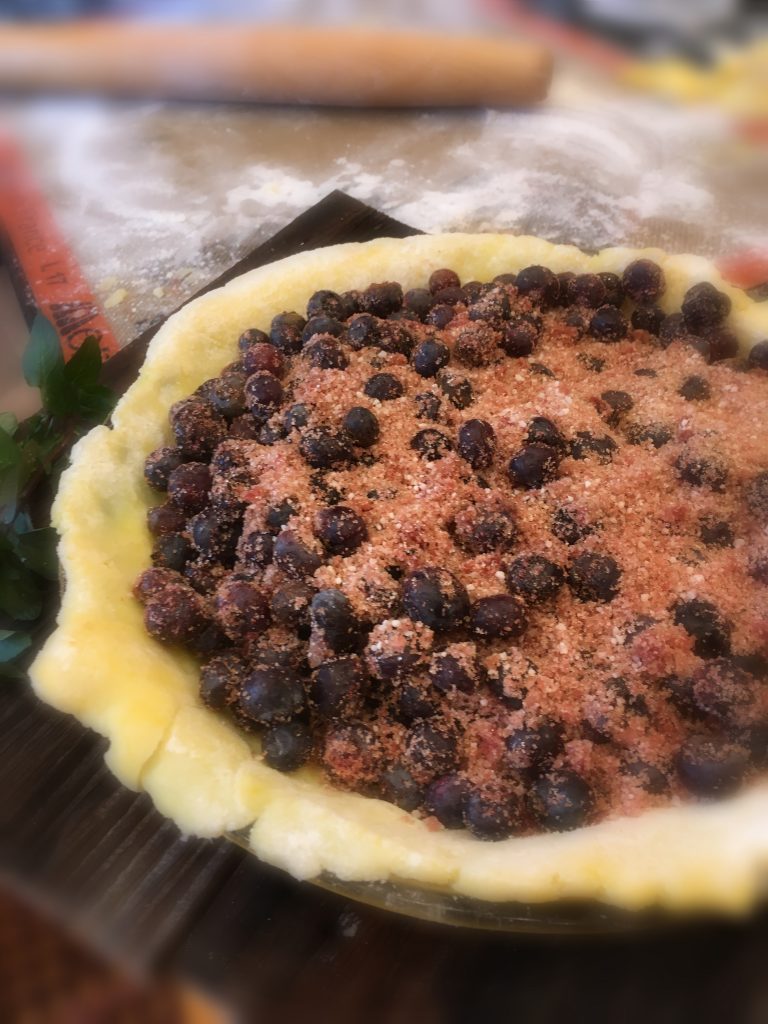…also happens to be Gluten Free. I’ve learned that a cafe in the heart of Catskill Mountain farm country, if it is to meet with local acceptance, must adhere to certain cultural rules.
Rule number one:
You gotta have pie.
Rule number two:
You gotta have GOOD pie.
And then, sympathizing with myself and all those other folks who suffer from intolerances & allergies to wheat, I tacked on an addendum:
You gotta have gluten-free pie.
Which then leads to rule number four, where new-fangled food notions meet up with long-time farm country expectations:
You gotta have GOOD gluten-free pie.
No. Wait. You need to do one better. You gotta have gluten-free pie that tastes better than any pie (GF or not) that can be found within a hundred mile radius.
So, with that challenge, I had to start with a pie crust recipe. What I’m about to divulge here is the most sought-after recipe for the cafe. Mom doesn’t like me giving away trade secrets, but so many folks are doing small Thanksgivings for the first time this year, it’s time to share a little.
However, because this is one of our “cafe secrets,” I’m wiping it off the blog at the end of the week. So pay attention!
Gluten Free Pie Crust
There are two secret ingredients that will help you master a gluten-free pie crust. The first is eggs. While a normal crust doesn’t call for them, the eggs here add structure, help to tenderize the dough, help the crust brown in the oven, keep the crust moist, and add a great nutritional bonus (Yippee! Pie for breakfast?!).
The second critical ingredient is LARD. While butter is included in the recipe to improve the overall flavor, half of the fat I’m calling for is lard, because it makes the crust flaky and gives the pie its authentic traditional flavor, but also produces a fluffiness that boosts the pie feasting experience from “nice pie,” to “whoa. That’s the best pie. EVER.” And thankfully, you folks are already well versed on the wholesome goodness of pastured pork lard, so I don’t need to drone on about that here. So here’s the recipe:
Makes 2 crusts
2 1/2 cups all-purpose GF flour blend
2 Tbs granulated sugar
1 tsp xanthan gum
1 tsp salt
3 ounces lard
3 ounces unsalted butter
2-3 eggs
4 tsp lemon juice
Combine the dry ingredients. Use a pastry cutter to blend in the fats, then stir in the eggs and lemon juice. The dough should hold together. If it is too dry, add 1-2 tablespoons water and/or the third egg. Mix until you can form it into a ball easily. Wrap in plastic and refrigerate for 2 hours, or until ready to use.
I’ve found that it’s best to take the dough out and leave it on the counter for 30-60 minutes before I use it. When I roll it out, I do it on a floured silicone baking mat. This is because the crust is more fragile than a wheat crust, and the baking mat enables me to lift it and turn it into the pie dish.
Another important tip: while I never greased a pie dish in my wheat days, I ALWAYS grease my pie dishes (with lard, of course) before laying in my crust.
Did your crust fall apart when you turned it into the dish? No problem. Use your fingers to gently press it into place in the pan. It will still bake up, hold together and lift from the pan easily.

So the biggest issue with gluten free pie crusts is the inability of it to hold together when being served. All crusts I have tried fall apart on the plate (or serving utensil) While the rest of the recipe looks like my prize winning pie crust, the addition of the eggs hold promise. I will be trying this out. Does it really hold together for serving?
Also, I’ll share with you my “secret” for rolling (I teach pie making classes)– Roll the dough between two sheets of parchment. You’ll be able to easily transport the crust to the pie dish without tearing.
Thank you for sharing!
Hiya; I serve about 8-16 slices each day the cafe is open, with none falling apart. I don’t use parchment to roll, but unlike a wheat crust, which is elastic, this one will pull apart at the edges when rolling. To prevent that, I work more slowly, doing one or two rolls, then stopping and re-working the edges together, then moving forward. It seems laborious, but it because second nature in no time, my fingers retracing the crust scanning for cracks, working them together, and then moving forward. It takes only a minute or two to roll the dough. Hope it works for you!
All gluten free pie crust mixes are not equal, so would you offer up the brand name or ingredient list. I would be most grateful as my son would love to have a slice of cherry pie with good crust. Thank you so much.
Hi; This recipe doesn’t call for a pie crust mix. It calls for a gluten-free flour blend. I make my own, but I’ve used King Arthur’s GF blend (not measure-for-measure) in this recipe with great results.